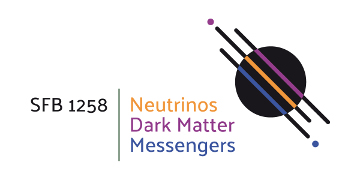From astrophysical observations, physicists conclude that there must be a mass component in the Universe that we can’t see. This dark matter makes up about 75% of the gravitational effective matter, compared to the 25% of visible matter. Despite of the overwhelming evidence for its existence, the nature of this dark matter is unknown. Currently, physicist favor the WIMPs, postulated massive particle that are only weakly interacting with the visible mass, as the most promising candidates for dark matter particles.
Searching for direct detection and annihilation signatures
A number of experiments are hunting for a WIMP direct detection, such as the CRESST experiment, one of the key experiments of the SFB1258. Presuming that dark matter particles annihilate, dark matter signals are also expected from neutrinos as final decay states detectable by neutrino telescopes like IceCube.
But what about the contributions to dark matter signatures from the different astrophysical sources? The answer depends largely on the astrophysical models used and naturally has large uncertainties. For our local Universe, this question has now been re-investigated by Alejandro Ibarra, professor for theoretical particle physics at TUM and principle investigator of the SFB1258, the TUM PhD student Andreas Rappelt and Bradley J Kavanagh from the University of Amsterdam.
Small structure merge into larger structures
Our Milky Way as most of the galaxies are embedded in a gigantic halo of dark matter particles. Physicists have deduced estimates for the overall density of this halo, but sub-halos must be considered in a realistic approach: According to the cosmological models of structure building in the Universe, small structures form first and then merge into larger structures. This implies, that the Milky Way and our solar system are not evenly filled with dark matter, but regions of different size with higher densities exist within the halo.
Large impact of sub-structures on direkt dark matter searches probable
In their probabilistic study Alejandro Ibarra and his collaborators investigated the presence of sub-halos on the interpretation of local direct dark matter searches. They calculated the probability of the Earth currently being inside a sub-halo, as well as the enhancement of the local dark matter density due to this. In broad consistency with previous studies, they found that the impact of local sub-halos on direct detection experiments can be large and should be taken into account when analyzing the results.
Annihilation singnals from the Sun expected not to be enhanced
Ibarra’s team also investigated the effect of the accumulation of dark matter particles within the Sun’s core: Dark matter particles traversing the Sun can scatter with solar matter and can thereby lose so much energy that they get gravitationally bound to the Sun. Once captured, the dark matter particles will eventually sink to the solar core generating an over-density of dark matter. A thus increased dark matter annihilation is considered to result in signals observable with neutrino telescopes. Previous studies have indeed demonstrated that sufficiently dense sub-structures, traversed by the Sun for a long enough time, may have a substantial impact on the neutrino signal. Contrary to these, Ibarra and coworkers now find that such encounters are rare and a realistic population of sub-structures is unlikely to result in a large enhancement of signals. “With this result, our work alleviates a major uncertainty of dark matter searches with neutrino telescopes”, Alejandro Ibarra resumes.
The authors emphasize that while they have made a number of assumptions about the properties and distributions of the dark matter sub-structure, the formalism developed can be adopted more generally. The study is focused on standard (cold) dark matter but the approach can be applied to other dark matter candidates also, they state.
Publication
A. Ibarra, B.J. Kavanagh, A. Rappelt: Impact of substructure on local dark matter searches, Journal of Cosmology and Astroparticle Physics JCAP12(2019)013, Dez 2019
Contact
Prof. Alejandro Ibarra
Technical University of Munich
Tel.: +49 89 289 12196
E-mail: ibarra@tum.de



